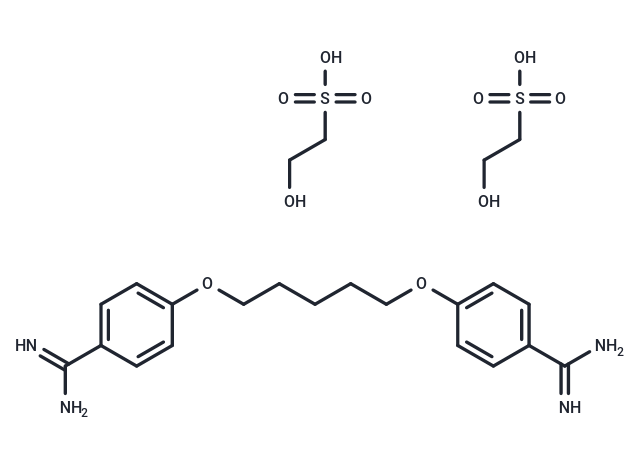Shopping Cart
- Remove All
 Your shopping cart is currently empty
Your shopping cart is currently empty

Pentamidine isethionate (Pentamidine diisethionate) is a synthetic amidine derivative, Pentamidine Isethionate is an antiprotozoal and antifungal agent.

| Pack Size | Price | Availability | Quantity |
|---|---|---|---|
| 100 mg | $33 | In Stock | |
| 200 mg | $39 | In Stock | |
| 1 mL x 10 mM (in DMSO) | $30 | In Stock |
| Description | Pentamidine isethionate (Pentamidine diisethionate) is a synthetic amidine derivative, Pentamidine Isethionate is an antiprotozoal and antifungal agent. |
| Targets&IC50 | Leishmania infantum:2.5 μM (IC50) |
| In vitro | Pentamidine is known experimentally to interfere with numerous cellular processes. Specifically, Pentamidine has been shown to bind to DNA in a nonintercalative manner and appears to preferentially bind to kinetoplast DNA in trypanosomes. Additionally, Pentamidine may inhibit RNA polymerase and ribosomal function, as well as nucleic acid, protein, phospholipid, and polyamine synthesis. Pentamidine also inhibits certain proteases, including trypsin, and impairs cellular oxygen consumption. [1] Pentamidine has a potent in vitro antiprotozoal activity. Pentamidine displays cytotoxic activity against L. infantum promastigotes with IC50 of 2.5 μM. 2.5 μM Pentamidine induces early programmed cell death in 49.6% of L. infantum promastigotes. 2.5 μM Pentamidine induces a notorious decrease in promastigotes in both G1 and S phases relative to the control-untreated samples (G1:77.0 vs 15.0%; S:11.0 vs 2.4% for control- and pentamidine-treated promastigotes, resp). Pentamidine is able to bind with calf-thymus DNA (CT-DNA) and induces conformational changes in the DNA double helix. Pentamidine also binds with ubiquitin to modifiy the β-cluster of ubiquitin. [2] Pentamidine is an inhibitor of phosphatase of regenerating liver (PRLs). 1 μg/mL of Pentamidine complete inhibits the activity of recombinant PTP1B in dephosphorylating a phos-photyrosine peptide. 10 μg/mL of Pentamidine completely inhibits the activities of recombinant PRL-1, PRL-2 and PRL-3 in dephosphorylating a phosphotyrosine peptide substrate. Incubation with Pentamidine (1 μg/mL) for 48 h reduces the activity of intracellular PRL phosphatases in transfected NIH3T3 cells by more than 85%. 10 μg/mL Pentamidine completely inhibits the growth of melanoma cell line (WM9), prostate carcinoma cell line (DU145 and C4–2), ovarian carcinoma cell line (Hey), colon carcinoma cell line (WM480), and lung carcinoma cell line (A549) which all express endogenous PRLs. [3] |
| In vivo | Pentamidine has a potent antiprotozoal activity in animal models. Pentamidine (0.3-9 mg/L) decreased the viability of P. carinii in experimental models in chick embryo lung epithelial cells and lung cells of rats with pneumonia. 5 mg/kg Pentamidine treatment for 2 weeks eradicates Pneumocystis carinii pneumonia in 75% of the animals. [4] Pentamidine inhibits the growth of WM9 human melanoma tumors in nude mice. During the 16-week study period, the tumors in 250 μg pentamidine-treated mice stays at sizes similar to those at the treatment initiation point, whereas the tumors in the control mice grow so rapidly that humane sacrifice of the animals is required at the 4th week. Pentamidine induces significant necrosis that accounts for more than 50% of the tumor mass. [3] |
| Kinase Assay | In vitro PTPase assays: Individual PTPases (0.01 μg/reaction) in 50 μL of PTPase buffer [50 mM Tris (pH 7.4)] are incubated at 22 ℃ for 10 min or as indicated in the absence or presence of inhibitory compounds. Substrates (0.2 mM phosphotyrosine peptide) are then added and allows to react at 22 ℃ for 18 hr. PTPase activity of individual reactions is measured by adding 100 μL of malachite green solution (UBI) and then quantifying the amounts of free phosphate cleaved by the PTPase from the peptide substrate by spectrometry (A660 nm). Relative PTPase activities are calculated based on the formula [(PTPase activity in the presence of an inhibitory compound)/(PTPase activity in the absence of the compound) × 100%]. Reactions performed under comparable conditions in the absence of recombinant PTPases only are used as controls and shows no detectable PTPase activity. |
| Cell Research | Cells are washed in 10% FCS contained RPMI 1640 medium twice, resuspended in 10% FCS medium, incubated at 37 ℃ for 16 hr, and then cultured at 37 ℃ in 10% FCS medium containing various amounts of Pentamidine for 6 days. The cell numbers in proliferation assays are determined by an MTT assay.(Only for Reference) |
| Alias | Pentamidine isethionate salt, Pentamidine diisethionate |
| Molecular Weight | 592.68 |
| Formula | C23H36N4O10S2 |
| Cas No. | 140-64-7 |
| Smiles | OCCS(O)(=O)=O.OCCS(O)(=O)=O.NC(=N)C1=CC=C(OCCCCCOC2=CC=C(C=C2)C(N)=N)C=C1 |
| Relative Density. | no data available |
| Storage | Powder: -20°C for 3 years | In solvent: -80°C for 1 year | Shipping with blue ice. | ||||||||||||||||||||||||||||||||||||||||
| Solubility Information | DMSO: 50 mg/mL (84.36 mM), Sonication is recommended. H2O: 168.7 mM, Sonication is recommended. | ||||||||||||||||||||||||||||||||||||||||
Solution Preparation Table | |||||||||||||||||||||||||||||||||||||||||
DMSO/H2O
H2O
| |||||||||||||||||||||||||||||||||||||||||

Copyright © 2015-2025 TargetMol Chemicals Inc. All Rights Reserved.